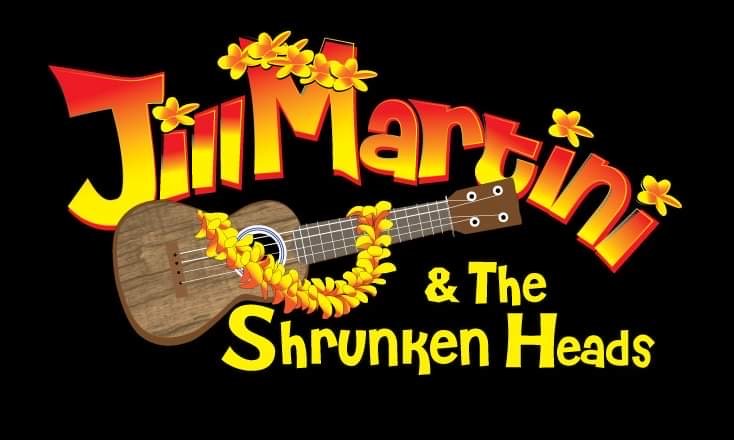Jill Martini & the Shrunken Heads invite you into the world of tiki for your instant Polynesian vacation!
Aloha! Relax and kick your shoes off…
What is tiki music and what will you you hear at a Jill Martini & the Shrunken Heads show?
This group is popular for their variety of song choices that surf the various waves of tiki music and for their musical flexibility of styles using acoustic instruments such as the ukulele and kiku, upright bass, percussion, and Hawaiian Steel guitar and guitar.
Whether you’re looking for upbeat surf, dark exotica, Hawaiian Hapa or traditional, this group does it all. They like to say: “Aloha! We do that.”
Who are the Shrunken Heads?
Miles Lang - Ukulele, Guitar, Hawaiian Steel Guitar Alec Graham - Bass Laika Martini - percussion and dance
What is “tiki”?
In the early 20th century, most Americans did not have the means to travel to tropical locations. Those who could, instantly fell in love with the culture, music, food, and drinks of the various islands they visited.
Travelers brought back locally-crafted souvenirs made from island resources, including artwork, household items, grass skirts, coconuts, and clothes made out of tapa cloth, (later cotton) with original native designs and colorful flower motifs. One such traveler, Donn Beach, brought the dream of traveling to tropical locations for the land-locked masses in Southern California. He opened the first “tiki bar” in Hollywood featuring unique recipes for strong tropical drinks and the tiki bar craze was on!
Celebrities flocked to his tiki bar “Don the Beachcomber’s” - some while filming Polynesian paradise movies on back lots of Hollywood studios. Since many people had never traveled to such locations, what was “tiki” became what the imagination (and Hollywood studios) created it to be.
Other tiki bars and restaurants cropped up in California as well, such as Trader Vic’s, The Seven Seas, Sugies Tropics, Damon’s, and many more.
The 1940’s brought on the tragedies of World War II, which further fueled the American public’s craving for exotic vacations in tropical paradise and the romance of Polynesia. American G.I.s brought back colorful Hawaiian shirts and trinkets with them, along with songs, stories, and photos from locations in the South Pacific,
By the 1950’s and 1960’s, more Americans had the means to travel to Polynesia and continued the trend of bringing back music, souvenirs, and fashions.
Today, this cultural phenomenon exists in a way no one could have imagined at the start of the 20th century. Tiki lovers around the world connect through social media to share all things tiki or tiki inspired such as: themed art, fashions, food, music, and of course, souvenirs - including the iconic “tiki mug” from which to sip exotic libations from the comfort of their favorite local tiki bars or even in their own home tiki bars.
Items to decorate such home tiki bars, clothes, and various items can be bought (or traded!) through the Internet and at pop-up tiki marketplaces just about anywhere tiki bars, restaurants or tiki themed hotels are. There is even an App called “Tikicomber” for use in connecting with other like-minded people looking for information about tiki bars, restaurants, stores, and pop-up events.
Of course, such gatherings cry out for tiki music to fill the heart and fuel the imagination with pleasurable dreams of Aloha.
The History of “tiki entertainment”:
As early as when phonographs first played recordings, people loved listening to the beautiful sounds of Polynesian artists. Hawaiian artists, in particular, developed unique ways of bringing their traditional songs to the airwaves accompanied by indigenous instruments and those brought to the islands, such as the steel guitar and the ukulele.
Radio shows brought the sounds of Hawaiian and other Polynesian artists to an audience far beyond their islands.
Movies, and later television, brought viewers sumptuous tropical scenes, hula dancing, and the music of Hawaii to a world-wide audience.
Hawaiian entertainers brought musical comedy into the mix early on. Honolulu native Hilo Hattie (Clara Inter), brought to California her style of Hawaiian music and entertainment, in 1938. That year, the Los Angeles Shriners hosted the Shriner’s National Convention and Honolulu’s Aloha Temple Shriners brought with them a group of Hawaiian entertainers with fun- loving Hilo Hattie. To this day, people wear fez’s at tiki events in tribute to the Shriner-tiki connection and Hilo Hattie tm is a brand of Hawaiian wear popular with the tiki community as the clothing line has been in productions for decades.
The waves of “tiki music”:
The love of “exotic” sounds fueled the imaginations of filmmakers and music producers in the 1940s and 1950’s. Jazz composers such as Les Baxter, Arthur Lyman, and Martin Denny weaved together tropical sounds with relaxing jazz and a style of music called “exotica” was born.
At the same time, artists such as Les Paul & Mary Ford, and Connie Francis released albums with songs from and about Hawaii and the South Seas.
Filmmakers looking to bring audiences what they craved - including rock and roll - brought Elvis Presley to the big screen in Blue Hawaii.
The activity of surfing, popular in Hawaii and in Southern California, gave imagination to artists in the 50’s and 60’s with the explosion of upbeat electric- guitar driven “surf-rock.” Artists such as Dick Dale, the Ventures, the Shantays, the Safari’s, and the Shadows make up the core of this wave. Pun intended.
The late 1960’s and 1970’s gave us modern Hawaiian artists popularizing Hawaiian entertainment such as Don Ho.
The late ‘70’s and ‘80s gave us the modern relaxed-beat rock sounds of “Yacht Rock.”

